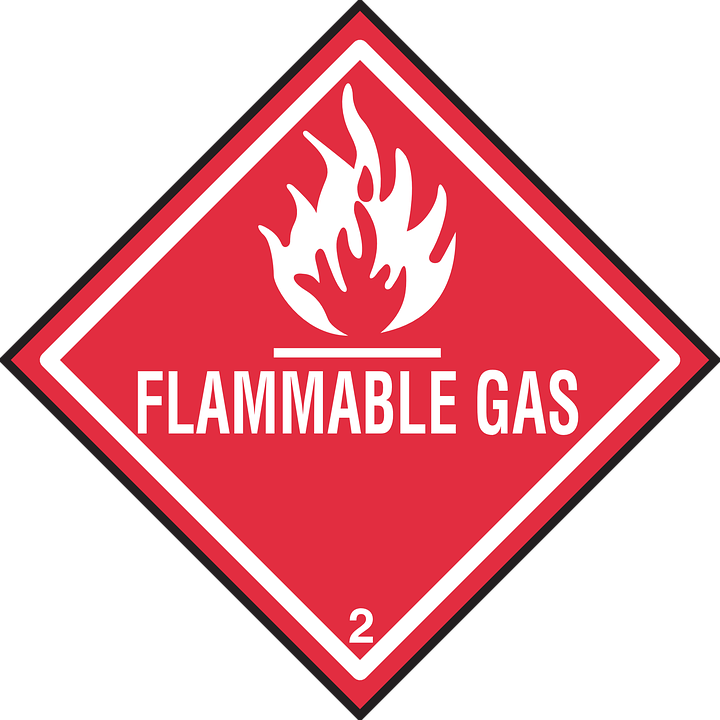Let’s talk about hazardous materials. What are they? Do you need compliant protection to store these dangerous chemicals? While the term “hazardous materials” sounds esoterically scientific, they are far more ubiquitous than you could ever imagine. For mass classification purposes, you should think of hazardous materials as any workplace chemical that can cause bodily harm or environmental contamination if not properly stored. While the term “hazardous” lends you to believe a hands off approach is necessary when encountering dangerous chemicals, this should be tempered with measured reassurance of their importance and their usefulness in application. Every industry uses hazardous materials. From powerful disinfectants to lubrications and fuel, hazardous materials have a welcomed place for every job. It’s only through negligence and misuse that manufacturers run afoul of government regulations. Still have questions? Let us be your designated guide in the potentially toxic world of hazardous materials storage.
Common Hazardous Materials
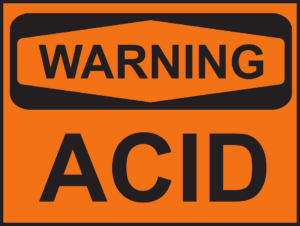
Hazardous materials run the industrial gamut. Everything from aerosol spray, bleach, ethanol to gasoline, car batteries, and certain pharmaceuticals meet the government’s definition of hazardous materials. But what about the chemicals that comprise common household and worksite products? Chemical compounds are unique formulas that specify each hazardous material. Even water (H20) is considered a hazardous material because of its potentially volatile reactivity with water. Although the potential list of chemical compounds is virtually inexhaustive, certain precursor chemicals are more common and dangerous than others. Chlorine, propane, sulfuric and hydrochloric acid, pyrotechnics, pesticides, and carbon dioxide are some of the most widely used hazardous chemicals used in manufacturing.
While we’re on the topic of hazardous materials, let’s talk about classification. Each hazardous material is classified based upon its physical composition, reactivity with other substances, potential volatility, and propensity to cause human and environmental harm. The Department of Transportation groups hazardous materials under seven distinct classifications. Those classifications include explosives, gases, flammable liquids, flammable solids, oxidizers and organic peroxide, poisons, and radioactive materials. Each classification of hazardous materials pose certain environmental risks. Moreover, each hazmat classification requires special consideration when securing federally compliant chemical storage.
Who Regulates Hazardous Materials?
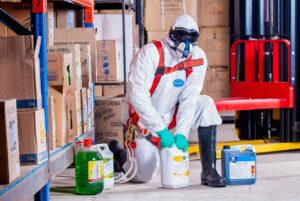
OSHA is pretty self righteous when it comes to compliant chemical protection, as they should be. They are the governmental clearing house for worker safety and safe materials handling. But let’s digress for a moment. OSHA isn’t the only agency that has a say about worker safety and hazardous materials. The National Fire Protection Association is a citizen and industry think tank tasked with developing industry standards for handling dangerous chemicals, primarily flammable liquids. They don’t have any enforcement purview, but OSHA does base a sizable chunk of their regulations on their advice. While OSHA is the guiding force of hazmat storage, you should also stay abreast of changing NFPA standards. When shopping for chemical storage protection, always look for NFPA compliant structures and containers for your hazardous materials stockpiles.
How Does Quantity Dictate Chemical Storage?
While the list of hazardous materials is 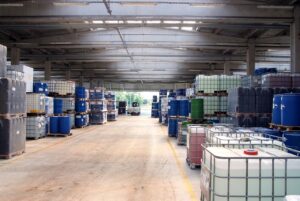 sizeable, let’s focus on flammable liquids, as they are the most commonly stored chemical on any jobsite. Any industry or organization requiring onsite flammable materials and liquids should consider compliant chemical storage protection. Any flammable stockpile fewer than 25 gallons is kosher with OSHA – you don’t need separate compartmentalized storage. But the parameters change with larger stockpiles. Any chemical stockpile greater than 25 gallons needs to be stored in an approved warehouse or container. OSHA requires that no more 60 gallons of flammable materials with a flashpoint at or below 140 can be stored in an approved hazmat warehouse. Larger stockpiles are given special attention. Furthermore, OSHA requires no more than 120 gallons of combustibles with a flashpoint at or above 140 degrees can be stored in a single hazmat warehouse.
sizeable, let’s focus on flammable liquids, as they are the most commonly stored chemical on any jobsite. Any industry or organization requiring onsite flammable materials and liquids should consider compliant chemical storage protection. Any flammable stockpile fewer than 25 gallons is kosher with OSHA – you don’t need separate compartmentalized storage. But the parameters change with larger stockpiles. Any chemical stockpile greater than 25 gallons needs to be stored in an approved warehouse or container. OSHA requires that no more 60 gallons of flammable materials with a flashpoint at or below 140 can be stored in an approved hazmat warehouse. Larger stockpiles are given special attention. Furthermore, OSHA requires no more than 120 gallons of combustibles with a flashpoint at or above 140 degrees can be stored in a single hazmat warehouse.
Flammable Liquids Classification
Before discussing compliant chemical storage, let’s breakdown the different classifications of hazardous materials. Although terminologies like “melting point” and “flashpoint” might sound confusing, as well as unnerving, following these simple guidelines can ensure lasting and compliant chemical storage protection.
- Class I Liquids: Flammable liquids that have a flash point below 100°F (37.8°C). They are further divided into three categories based on their volatility:
- Class IA: Liquids with a flash point below 73°F (22.8°C) and a boiling point below 100°F (37.8°C).
- Class IB: Liquids with a flash point below 73°F (22.8°C) and a boiling point at or above 100°F (37.8°C).
- Class IC: Liquids with a flash point at or above 73°F (22.8°C) and below 100°F (37.8°C).
- Class II Liquids: Combustible liquids with a flash point at or above 100°F (37.8°C) and below 140°F (60°C). They are also divided into three categories based on their flash points.
- Class IIIA Liquids: Combustible liquids with a flash point at or above 140°F (60°C) and below 200°F (93.4°C).
- Class IIIB Liquids: Combustible liquids with a flash point at or above 200°F (93.4°C).
All Category I, II, or III flammable liquids should be kept in closed containers when not in use.
What Does Chemical Storage Look Like?
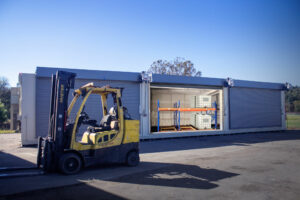
When discussing chemical storage, industry experts will commonly use certain terms like hazmat warehouse, chemical storage locker, and fire cabinet interchangeably with one another. Despite nuances in terminology, all these terms allude to the same thing: compliant chemical storage. A chemical storage locker can be as small as a wooden cabinet and as large as a Conex-style trailer. Sizing of a required chemical storage warehouse will locker will depend upon stockpile volume and flammability. We often recommend chemical storage lockers that superficially resemble shipping containers to the untrained eye for larger flammable materials payloads. As a reminder, NFPA 30 Section 9.5 says the total volume for storage of Class I, Class II, and Class IIIA liquids should not surpass 120 gallons in a single storage locker or cabinet.
What Are The Structural Requirements of a Chemical Storage Locker?
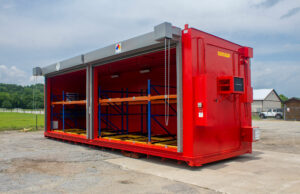
Now we’re getting down to the nitty-gritty of hazardous material protection. Although OSHA guidelines for compliant hazmat warehouses are complex, all material handlers should follow a few simple rules when evaluating different storage options. NFPA 30 Section 9.5 for metal safety cabinets requires the “bottom, top, door, and sides of the (storage) cabinet shall be at least No. 18 gauge sheet steel and shall be double-walled.” Moreover, OSHA has stipulations for material strength. Per governmental regulation, all chemical storage lockers should be made up 18 gauge steel sheet protection from top to bottom. Furthermore, all hazmat lockers should have a three-latch door arrangement. All joints should also be riveted, welded, or made tight. Furthermore, the NFPA also says the door sill of the container should be raised at least two inches above the bottom of the cabinet to retain spilled liquid inside the storage locker.
Storage cabinets designed and constructed to limit the internal temperature at the center of the cabinet and 1 in. (25 mm) from the top of the cabinet to not more than 325°F (163°C), when subjected to a 10-minute fire test that simulates the fire exposure of the standard time–temperature curve specified in ASTM E 119, Standard Test Methods for Fire Tests of Building Construction and Materials, shall be acceptable. Source: NFPA 30 9.5
Wood vs Steel Chemical Storage Lockers 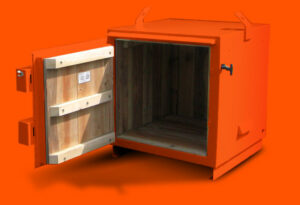
Although NFPA 30 allows for the wooden construction of hazmat cabinets, they come with abject deficiencies. Moreover, wood is unacceptable for storing larger quantities of flammable materials. U.S. Hazmat Storage recommends a steel solution for almost all hazardous material storage dilemmas. Although wood is welcomed in construction, it offers different benefits than steel. Steel construction allows for equipping optional fire suppression, ventilation, and climate control in a storage locker. All U.S. Hazmat Storage warehouses also have a steel-grated floor sump containment system attached to the bottom of the locker. During an accidental spill, the liquid will pass through the steel grate floor and into a large sump until extraction.
Perennial Steel Protection For Every Job and Workflow
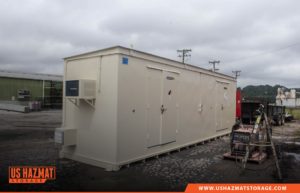
Still confused? Don’t feel intimidated. Understanding the complexities of hazardous materials and compliant storage cannot be passively learned. We can alleviate your chemical storage woes with NFPA 30 compliant chemical storage that can accommodate varying classifications of flammable materials. As a manufacturer, you have a vested interest in securing the proper chemical storage locker for your facilities, employees, and the communities you serve. Every chemical storage dilemma requires adept chemical classification knowledge. Our team of seasoned building advisors will accurately assess your chemical storage needs before presenting the chemical storage locker that is right for you. Contact us today for a free quote and consultation. We will provide a detailed quote and price as soon as possible.


